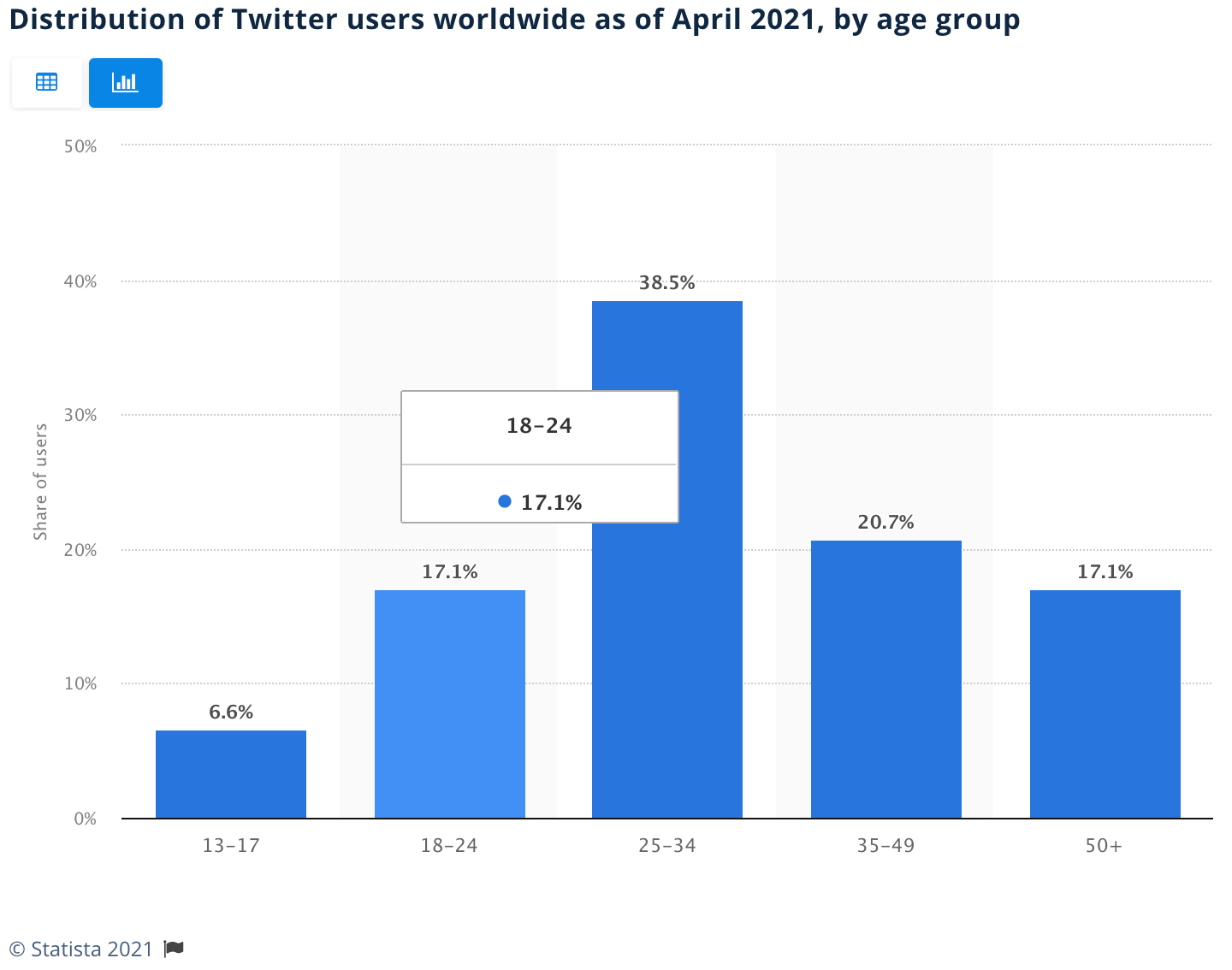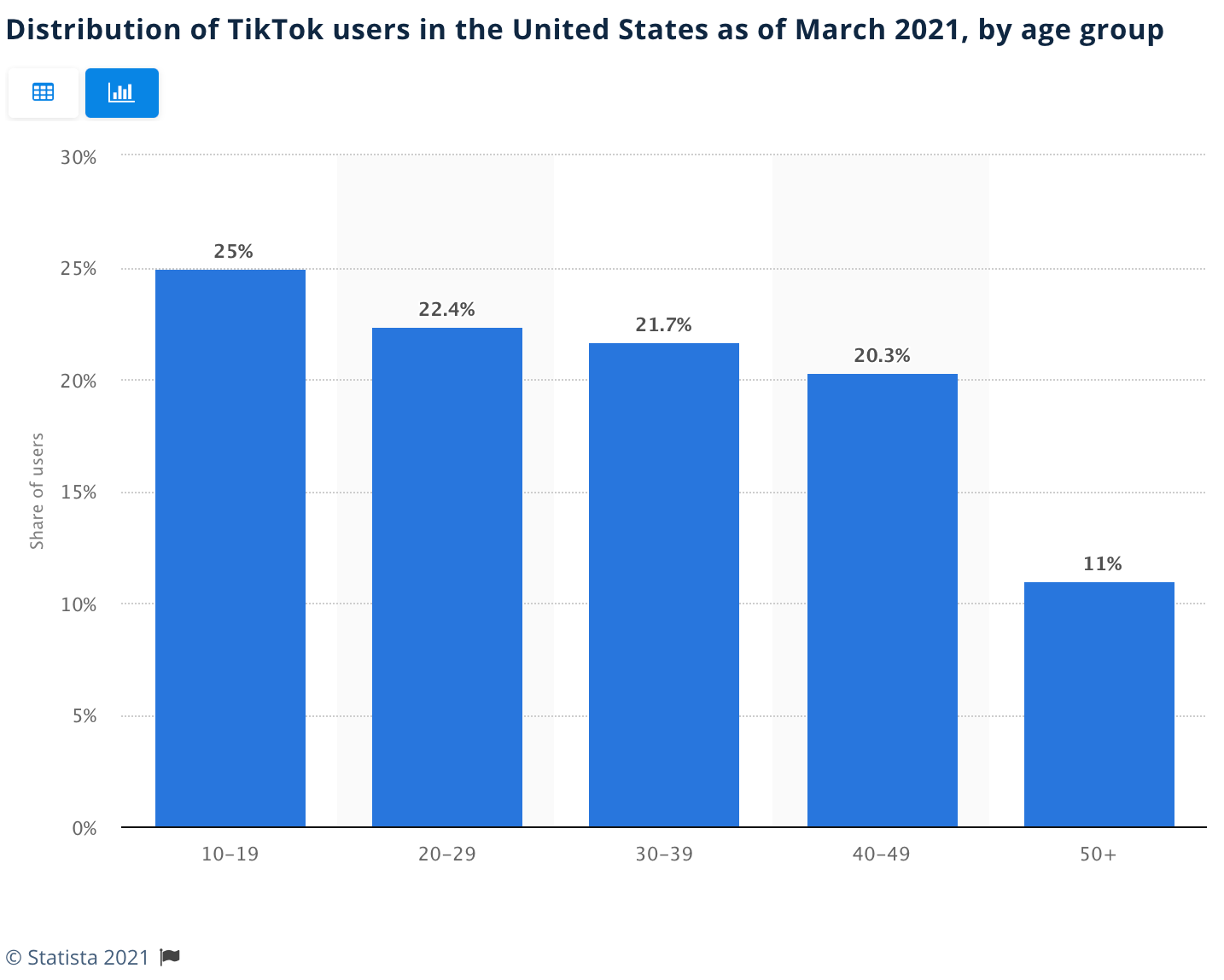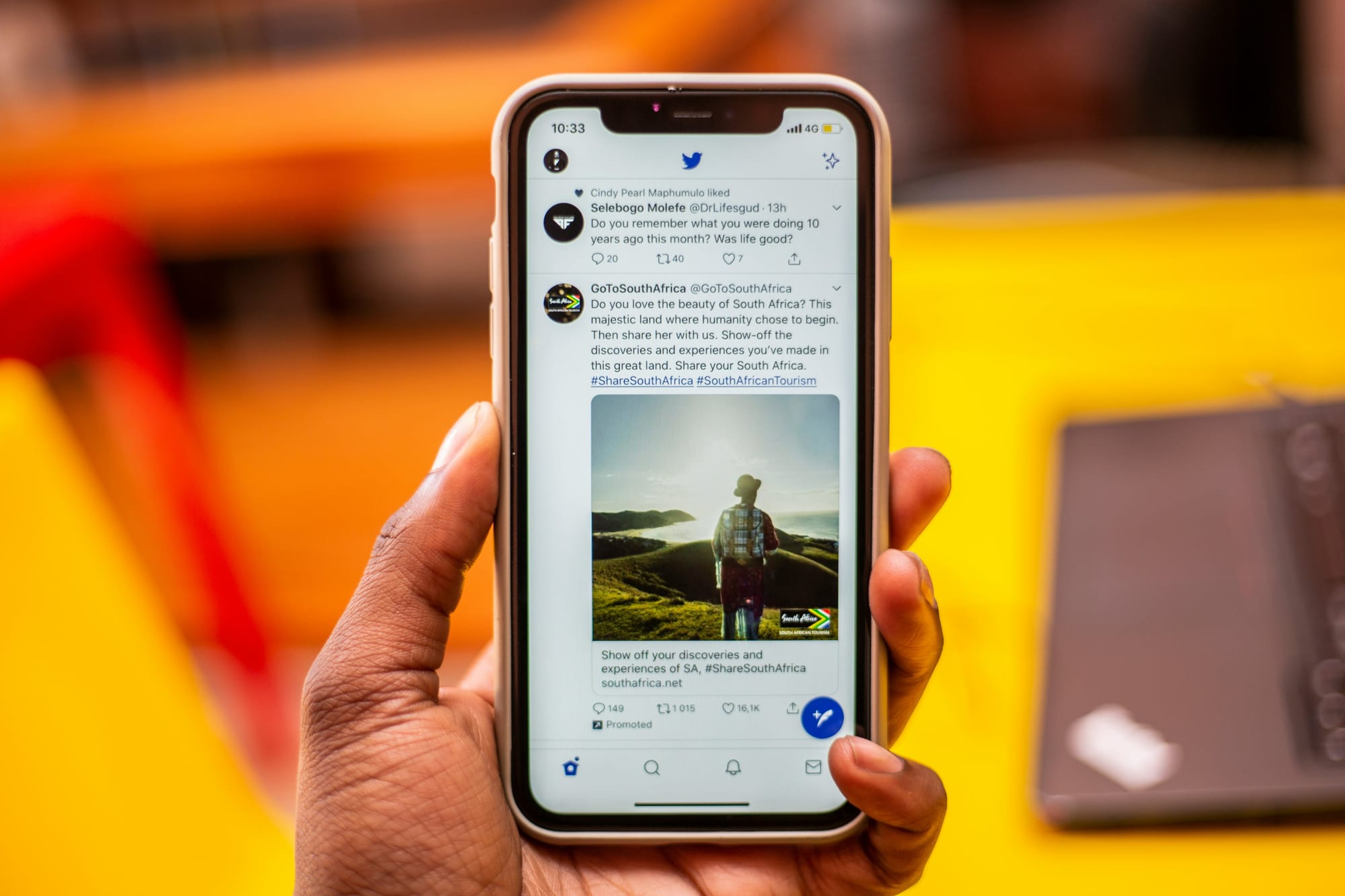When you’re a small business owner, you usually don’t have the budget or time for high-cost, comprehensive marketing strategies like large companies do. You need to focus on low-cost options that don’t take a lot of time to maintain. Platforms like email and unpaid social media marketing can introduce the world to your brand and grow your customer base even without advanced marketing expertise or budgets.
Social media is unique in that it’s more interactive. In your emails, customers click on links, but they typically don’t encourage two-way communication. On social media, you can start conversations with your customers (and future customers!). Every post opens up the opportunity for dialogue, so it’s a perfect channel to connect with your followers and build trusting relationships. Plus, social media can help you grow your audience because it can put your content in front of new audiences in your followers’ networks.
With just over one in five adults in the U.S. on Twitter, there’s a good chance your customers are on Twitter. Once you understand some basic Twitter best practices and know the types of posts that resonate with your followers, Twitter can become a gateway to developing a loyal fan base for your small business.
Craft the re-tweet-worthy tweets, learn what works and schedule your posts at the right time (in half the time) with Buffer's Twitter scheduling and analytics tools.
Can your small business do well on Twitter?
Just about any type of business can thrive on Twitter, whether you own an online e-commerce store, local coffee shop, hair salon, or handmade gift shop. If your customers are on Twitter, you can be successful on Twitter.
If you only have time to invest in one or two social media platforms, you want to make sure Twitter is one of the places where your customers are most active. There are a few ways to find out.
1. Ask your customers
The easiest way to find out if your customers are active on Twitter is to ask! If you’re an online business already and have an email list, send a quick survey about social media. Ask your customers which social media channels they use most frequently, what kinds of content they share, and which ones they follow brands on.
SurveyMonkey and Typeform are two free options to gather info from your email list. Here’s a social media survey template from Typeform for inspiration. Customize it to find out what you want to know about your audience.
No email list? If you have a physical store, get a temperature check at the cash register. While checking out a customer, tell them you’re thinking of getting on social media and ask if they follow brands online and which platforms they use.
2. Compare your target audience to Twitter’s audience
Each social media platform has certain groups of people who are more active than others. You’ll want to compare your target audience’s demographics (information like gender, age, geographical location, income, etc.) and psychographic data (psychological traits like personality, interests, and values) with the social media platforms you’re considering.
For example, the most active age group on Twitter is millennials, while TikTok is where Gen Z hangs out.


3. Look to your competitors
Every one of your competitors’ customers is a potential customer for you. So if your competitors are doing well on Twitter, it’s likely your people are on Twitter. You just need to start tweeting!
If your competitors aren't on Twitter, it could be a sign that it's not the right platform. However, if you have reason to believe otherwise — say, multiple existing customers have told you they'd follow your brand on Twitter — disregard your competitors and create an account. Twitter could be a goldmine that you'll be the first brand in your niche to discover!
How Twitter can help your small business grow
Twitter can become a thriving part of your business to interact with customers and find new ones.
In a 2021 survey of 4,300 marketers, Social Media Examiner found that Twitter is used by nearly half of business-to-consumer (B2C) marketers (i.e., marketers that work for brands that sell to consumers as opposed to brands that sell to businesses, like the software you use for your website). And it’s not hard to see why.
According to the report, 88% of marketers increase business exposure through their efforts on social media. Seventy-nine percent of them report increased traffic to their website. Other benefits include developing loyal fans, improving sales, and growing business partnerships.
Just look at Healthy Roots Dolls. Founded by Yelitsa Jean-Charles in 2014, Healthy Roots Dolls creates dolls and storybooks that represent and empower young black girls and their curls.
She uses Twitter to spread the brand’s mission and has seen incredible results: tripling her mailing list and gaining new leads for media and business partnerships.
This recent Tweet had great engagement and showed a girl playing with her Zoe doll:
How did she do? 🤔
— Healthy Roots Dolls (@RootsDolls) July 14, 2021
📸 : IG/@oohhclare pic.twitter.com/Ug78v0wXL6
What types of content do well for small businesses on Twitter?
Twitter is fast-paced. It’s all about content that can be read or viewed in a matter of seconds, so visuals and punchy text are both musts. The point you’re getting across has to stand out in people’s Twitter feeds. So, there are a few types of content that do particularly well on Twitter:
Pop culture trends and news
Responding to pop culture trends and news items is a great way to connect with your audience on current events.
In this Tweet, confection brand MoonPie responds to a SpaceX announcement:
My idea was better https://t.co/EZXmr5Dzrc pic.twitter.com/Ox5aQ4g8se
— MoonPie (@MoonPie) April 30, 2020
Thought-provoking content
If your brand stands for something, make it known! It’s a way to connect with your customers on the values you share. It can also be polarizing, so make sure it’s a message you want to represent your brand. Mercy for Animals uses its Twitter account to post challenging content about animal rights to further its mission.
Humor and wit
Tapping into humor that your customers can relate to can make them feel seen and can give your brand a feeling of approachability. Here, Dutch Bros winks at its own reputation for having a cult-like following:
Yeah they might be cute but do they know your Dutch order 👀
— Dutch Bros Coffee (@DutchBros) October 6, 2021
In this Tweet, CBD gummy brand Not Pot uses a meme to connect with its fans about the sleep issues many face who use CBD.
oh no pic.twitter.com/AVx79P3OjX
— Not Pot Dealer (@notpotdealer) April 29, 2020
Whatever you post, though, it’s important to relate it back to your business. Not Pot’s commentary on sleep only works because it’s something many of its customers can relate to. But it wouldn’t make sense for another business like a hair salon.
Read more about other types of Tweets that do well on Twitter.
7 best practices for small businesses on Twitter
As you post on Twitter, keep in mind other best practices to be successful.
1. Be relatable, not salesy
People don’t want to be sold to on social media. Posting on Twitter is less about promoting your product and more about relating to your customers.
If you are posting about your new products, it should be in the mix with a lot of other non-salesy content. You can get away with some direct product promotion by also posting enough funny or thought-provoking non-sales content to make your account worth following.
2. Post media directly on Twitter instead of linking out
All social media websites prioritize media that’s posted directly on the platform over something that’s linked out. By posting a photo or video right on Twitter, you make sure it gets seen by as many eyes as possible.
Plus, if people are on Twitter, it’s because they want to be there, not on YouTube. So limit how frequently you link out to other websites, including your own website.
3. Don’t copy-paste content from your other channels
If someone follows you in multiple places, you need to provide a unique experience on each platform. If you send out an email and then use the subject line as a tweet, there’s nothing new for them to interact with. There’s no reason for people to follow you in both places. So adapt your content for different platforms.
4. Interact with your followers
Having a great social media presence is more than posting great content. You need to engage with the people who are engaging with your content on Twitter.
Follow people back, like their posts, and respond to comments to keep the conversation going and build relationships with your fans. It will encourage people to keep interacting with you on Twitter.
5. Supplement your scheduled posts with real-time tweets
Responding to what’s going on in the world right now makes you relevant to your fans.
When the power went out at the 2013 Super Bowl, this tweet from Oreo went live within minutes. It was simple, relevant, and funny.
Power out? No problem. pic.twitter.com/dnQ7pOgC
— OREO Cookie (@Oreo) February 4, 2013
6. Earn followers, don’t buy them
It can be tempting to buy Twitter followers to boost your metrics, but it won’t do anything for your business. Those bought followers aren’t going to read or interact with your posts. And if people find out, it’s not a good look.
Instead, focus on creating engaging content to draw in new fans. Consider encouraging your existing customers to follow you on Twitter. Put your Twitter handle at the bottom of emails or on a board by your cash register. You could even consider a limited-time incentive, such as entering a giveaway raffle or earning a discount for following your brand’s Twitter.
7. Post consistently
It’s going to take time to build your following. It might seem like nobody’s listening at the beginning, and that’s okay!
Be patient and keep posting consistently. Once a week is plenty to get your fans in the habit of interacting with you on Twitter.
Wondering about whether or not you should get verified on Twitter? Read about how to get verified on Twitter and whether or not the blue check mark is worth it.
How to measure success on Twitter
Success is a sliding scale depending on your business size and goals, but these metrics can help you determine your performance and measure your growth over time.
- Followers: You want to build your following so that there are people who interact with you, but don’t get stuck on this number. It doesn’t indicate engagement.
- Likes: On many social platforms, “likes” don’t indicate true engagement. Likes can come from bots, and even when they don’t, many people are clicking the like button and moving on. However, unlike Instagram, where a “like” is almost entirely a vanity metric, likes on Twitter do have an added benefit. When one of your followers likes your post, it can show up in their followers' feeds — even though their followers don't follow you.
- Retweets: Retweets are better than likes. It means people value your post enough to share it with their friends. It helps spread your message!
- Comments: Comments start conversations. Commenting is a deeper level of engagement than a like, and it gives you insight into what your customers care about.
- Engagement: Engagement is the overall metric that you want to track. It tells you the percentage of Twitter users interacting with your content as it relates to your follower count. Liking, retweeting, commenting, clicking, these all count toward engagement. A high percentage of loyal and engaged followers with a small number of followers is better than a large following and low engagement. High engagement means you have the right people following you on Twitter.
Don’t be discouraged in the beginning as you build your following. It takes some time to get your Twitter account off the ground. Your follower count and engagement rate will be low to start, but if you post consistently, engage with your followers, and encourage the right people to follow you, you’ll be well on your way to growing your small business on Twitter.
Not sure how to use Twitter Analytics? Here’s how to access it and the most useful stats to look at.
Use a social media scheduling tool to save time and maintain consistency
As an entrepreneur, you have dozens of projects to manage at your small business and adding Twitter is no small thing. Save time on this new marketing endeavor while maintaining consistency by using a social media marketing tool like Buffer. You can set up posts weeks in advance, so your brand never goes dark on Twitter. Plus, it gives you space to pop in for real-time engagement with your fans.
The best part? Buffer is free for up to three social media accounts and to schedule up to 10 posts in advance on each one.






